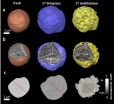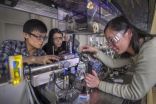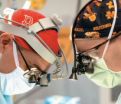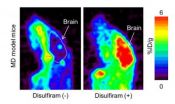(Press-News.org) UPTON, NY-Scientists at the U.S. Department of Energy's Brookhaven National Laboratory have made the first 3D observations of how the structure of a lithium-ion battery anode evolves at the nanoscale in a real battery cell as it discharges and recharges. The details of this research, described in a paper published in Angewandte Chemie, could point to new ways to engineer battery materials to increase the capacity and lifetime of rechargeable batteries.
"This work offers a direct way to look inside the electrochemical reaction of batteries at the nanoscale to better understand the mechanism of structural degradation that occurs during a battery's charge/discharge cycles," said Brookhaven physicist Jun Wang, who led the research. "These findings can be used to guide the engineering and processing of advanced electrode materials and improve theoretical simulations with accurate 3D parameters."
Chemical reactions in which lithium ions move from a negatively charged electrode to a positive one are what carry electric current from a lithium-ion battery to power devices such as laptops and cell phones. When an external current is applied-say, by plugging the device into an outlet-the reaction runs in reverse to recharge the battery.
Scientists have long known that repeated charging/discharging (lithiation and delithiation) introduces microstructural changes in the electrode material, particularly in some high-capacity silicon and tin-based anode materials. These microstructural changes reduce the battery's capacity-the energy the battery can store-and its cycle life-how many times the battery can be recharged over its lifetime. Understanding in detail how and when in the process the damage occurs could point to ways to avoid or minimize it.
"It has been very challenging to directly visualize the microstructural evolution and chemical composition distribution changes in 3D within electrodes when a real battery cell is going through charge and discharge," said Wang.
A team led by Vanessa Wood of the university ETH Zurich, working at the Swiss Light Source, recently performed in situ 3D tomography at micrometer scale resolution during battery cell charge and discharge cycles.
Achieving nanoscale resolution has been the ultimate goal.
"For the first time," said Wang, "we have captured the microstructural details of an operating battery anode in 3D with nanoscale resolution, using a new in-situ micro-battery-cell we developed for synchrotron x-ray nano-tomography-an invaluable tool for reaching this goal." This advance provides a powerful new source of insight into microstructural degradation.
Building a micro battery
Developing a working micro battery cell for nanoscale x-ray 3D imaging was very challenging. Common coin-cell batteries aren't small enough, plus they block the x-ray beam when it is rotated.
"The whole micro cell has to be less than one millimeter in size but with all battery components-the electrode being studied, a liquid electrolyte, and the counter electrode-supported by relatively transparent materials to allow transmission of the x-rays, and properly sealed to ensure that the cell can work normally and be stable for repeated cycling," Wang said. The paper explains in detail how Wang's team built a fully functioning battery cell with all three battery components contained within a quartz capillary measuring one millimeter in diameter.
By placing the cell in the path of high-intensity x-ray beams generated at beamline X8C of Brookhaven's National Synchrotron Light Source (NSLS), the scientists produced more than 1400 two-dimensional x-ray images of the anode material with a resolution of approximately 30 nanometers. These 2D images were later reconstructed into 3D images, much like a medical CT scan but with nanometer-scale clarity. Because the x-rays pass through the material without destroying it, the scientists were able to capture and reconstruct how the material changed over time as the cell discharged and recharged, cycle after cycle.
Using this method, the scientists revealed that, "severe microstructural changes occur during the first delithiation and subsequent second lithiation, after which the particles reach structural equilibrium with no further significant morphological changes."
Specifically, the particles making up the tin-based anode developed significant curvatures during the early charge/discharge cycles leading to high stress. "We propose that this high stress led to fracture and pulverization of the anode material during the first delithiation," Wang said. Additional concave features after the first delithiation further induced structural instability in the second lithiation, but no significant changes developed after that point.
"After these initial two cycles, the tin anode shows a stable discharge capacity and reversibility," Wang said.
"Our results suggest that the substantial microstructural changes in the electrodes during the initial electrochemical cycle-called forming in the energy storage industry-are a critical factor affecting how a battery retains much of its current capacity after it is formed," she said. "Typically a battery loses a substantial portion of its capacity during this initial forming process. Our study will improve understanding of how this happens and help us develop better controls of the forming process with the goal of improving the performance of energy storage devices."
Wang pointed out that while the current study looked specifically at a battery with tin as the anode, the electrochemical cell her team developed and the x-ray nanotomography technique can be applied to studies of other anode and cathode materials. The general methodology for monitoring structural changes in three dimensions as materials operate also launches an opportunity to monitor chemical states and phase transformations in catalysts, other types of materials for energy storage, and biological molecules.
The transmission x-ray microscope used for this study will soon move to a full-field x-ray imaging (FXI) beamline at NSLS-II, a world-class synchrotron facility now nearing completion at Brookhaven Lab. This new facility will produce x-ray beams 10,000 times brighter than those at NSLS, enabling dynamic studies of various materials as they perform their particular functions.
INFORMATION:
Jiajun Wang and Yu-chen Karen Chen-Wiegart are research associates in Wang's research group and performed the work together.
This research was funded as a Laboratory Directed Research and Development project at Brookhaven Lab and by the DOE Office of Science. The transmission x-ray microscope used in this work was built with funding from the American Recovery and Reinvestment Act.
DOE's Office of Science is the single largest supporter of basic research in the physical sciences in the United States, and is working to address some of the most pressing challenges of our time. For more information, please visit science.energy.gov.
One of ten national laboratories overseen and primarily funded by the Office of Science of the U.S. Department of Energy (DOE), Brookhaven National Laboratory conducts research in the physical, biomedical, and environmental sciences, as well as in energy technologies and national security. Brookhaven Lab also builds and operates major scientific facilities available to university, industry and government researchers. Brookhaven is operated and managed for DOE's Office of Science by Brookhaven Science Associates, a limited-liability company founded by the Research Foundation for the State University of New York on behalf of Stony Brook University, the largest academic user of Laboratory facilities, and Battelle, a nonprofit applied science and technology organization.
Related Links
Scientific paper: "In Situ Three Dimensional Synchrotron X-ray Nano-tomography of (De)lithiation Process in Sn Anodes"
http://dx.doi.org/10.1002/anie.201310402
Scientists track 3D nanoscale changes in rechargeable battery material during operation
First 3D nanoscale observations of microstructural degradation during battery charge-discharge cycles
2014-03-26
ELSE PRESS RELEASES FROM THIS DATE:
New clue to autism found inside brain cells
2014-03-26
The problems people with autism have with memory formation, higher-level thinking and social interactions may be partially attributable to the activity of receptors inside brain cells, researchers at Washington University School of Medicine in St. Louis have learned.
Scientists were already aware that the type of receptor in question was a potential contributor to these problems – when located on the surfaces of brain cells. Until now, though, the role of the same type of receptor located inside the cell had gone unrecognized. Such receptors inside cells significantly ...
Counting calories in the fossil record
2014-03-26
Starting about 250 million years ago, at the end of the Permian period, brachiopod groups disappeared in large numbers, along with 90 percent of the planet's species. Today, only a few groups, or genera, of brachiopods remain. "Most people won't be familiar with brachiopods. They're pretty rare in the modern ocean," said Jonathan Payne, a paleobiologist at Stanford University.
Meanwhile, bivalves flourished, diversifying into a staggering variety of shapes and sizes, and spread from marine to freshwater habitats. "After the end-Permian mass extinction, we find far fewer ...
Last drinks: Brain's mechanism knows when to stop
2014-03-26
The study found a 'stop mechanism' that determined brain signals telling the individual to stop drinking water when no longer thirsty, and the brain effects of drinking more water than required.
Researcher Professor Derek Denton from the Faculty of Medicine, Dentistry and Health Sciences at the University of Melbourne said the study provided insight into the human instincts that determine survival behaviour and are also of medical importance.
"Different areas of the brain involved in emotional decision-making were activated when people drank water after becoming ...
Two spine surgeons are 3 times safer than 1
2014-03-26
Seattle, WA—A new team approach has improved safety—reducing rates of major complications by two thirds—for complex spinal reconstructive surgery for spinal deformity in adult Group Health patients at Virginia Mason Hospital & Seattle Medical Center. An article in the March issue of Spine Deformity gives a detailed description of the standardized protocol before, during, and after the surgery, stressing the new approach's three main features:
Two spine surgeons in the operating room
A live preoperative screening conference
Monitoring bleeding during the operation
The ...
ATHENA desktop human 'body' could reduce need for animal drug tests
2014-03-26
Creating surrogate human organs, coupled with insights from highly sensitive mass spectrometry technologies, a new project is on the brink of revolutionizing the way we screen new drugs and toxic agents.
ATHENA, the Advanced Tissue-engineered Human Ectypal Network Analyzer project team, is developing four human organ constructs – liver, heart, lung and kidney – that are based on a significantly miniaturized platform. Each organ component will be about the size of a smartphone screen, and the whole ATHENA "body" of interconnected organs would fit neatly on a desk.
"By ...
Life expectancy gains elude overweight teens
2014-03-26
Washington, DC—Although people live longer today than they did 50 years ago, people who were overweight and obese as teenagers aren't experiencing the same gains as other segments of the population, according to a new study published in the Endocrine Society's Journal of Clinical Endocrinology & Metabolism (JCEM).
The life expectancy of the average American born in 2011 was 78.7 years, according to the U.S. Centers for Disease Control and Prevention. The average lifespan has increased by more than a decade since 1950, but rising obesity rates threaten to take a toll on ...
Sugary drinks weigh heavily on teenage obesity
2014-03-26
New research shows sugary drinks are the worst offenders in the fight against youth obesity and recommends that B.C. schools fully implement healthy eating guidelines to reduce their consumption.
Data from the 2008 Adolescent Health survey among 11,000 grade seven to 12 students in British Columbia schools indicates sugary drinks like soda increased the odds of obesity more than other foods such as pizza, french fries, chips and candies.
The study, published today in the International Journal of Behavioral Nutrition and Physical Activity, found that students in schools ...
Research: Less invasive technique possible in vulvar cancer treatment
2014-03-26
A team of researchers from Women & Infants Hospital of Rhode Island commanded a national stage to present the results of a study evaluating the use of sentinel lymph node dissection in women with vulvar malignancies, and then follow the patients for complications and recurrence.
The team – Drs. Richard G. Moore, Dario Roque, Carolyn McCourt, Ashley Stuckey, Paul A. DiSIlvestro, James Sung, Margaret Steinhoff, Cornelius Granai III, and Katina Robison – presented their work at the annual meeting of the Society of Gynecologic Oncologists (SGO) in Tampa. The oral presentation ...
Lack of coronin 1 protein causes learning deficits and aggressive behavior
2014-03-26
This news release is available in German.
Organisms must be able to sense signals from the outside and translate these into biochemical cues in order to adequately respond to their environment. This capability is also required to process information that reaches the brain. Within the brain, stimulation of neurons activates genes that are required, for example for learning and memory. In collaboration with an international and interdisciplinary team the research group led by Prof. Jean Pieters from the Biozentrum, University of Basel, has now uncovered the role of ...
Using PET scanning to evaluate therapies of Menkes disease
2014-03-26
Scientists at the RIKEN Center for Life Science Technologies have used PET imaging to visualize the distribution in the body of copper, which is deregulated in Menkes disease, a genetic disorder, using a mouse model. This study lays the groundwork for PET imaging studies on human Menkes disease patients to identify new therapy options.
Menkes disease, though rare, is a fearsome genetic disorder. Most affected babies die within the first few years of life. The disease is caused by an inborn fault in the body's ability to absorb copper. The standard treatment today for ...
LAST 30 PRESS RELEASES:
Statins significantly reduce mortality risk for adults with diabetes, regardless of cardiovascular risk
Brain immune cells may drive more damage in females than males with Alzheimer’s
Evidence-based recommendations empower clinicians to manage epilepsy in pregnancy
Fungus turns bark beetles’ defenses against them
There are new antivirals being tested for herpesviruses. Scientists now know how they work
CDI scientist, colleagues author review of global burden of fungus Candida auris
How does stroke influence speech comprehension?
B cells transiently unlock their plasticity, risking lymphoma development
Advanced AI dodel predicts spoken language outcomes in deaf children after cochlear implants
Multimodal imaging-based cerebral blood flow prediction model development in simulated microgravity
Accelerated streaming subgraph matching framework is faster, more robust, and scalable
Gestational diabetes rose every year in the US since 2016
OHSU researchers find breast cancer drug boosts leukemia treatment
Fear and medical misinformation regarding risk of progression or recurrence among patients with breast cancer
Glucagonlike peptide-1 receptor agonists and asthma risk in adolescents with obesity
Reviving dormant immunity: Millimeter waves reprogram the immunosuppressive microenvironment to potentiate immunotherapy without obvious side effects
Safety decision-making for autonomous vehicles integrating passenger physiological states by fNIRS
Fires could emit more air pollution than previously estimated
A new way to map how cells choose their fate
Numbers in our sights affect how we perceive space
SIMJ announces global collaborative book project in commemoration of its 75th anniversary
Air pollution exposure and birth weight
Obstructive sleep apnea risk and mental health conditions among older adults
How talking slows eye movements behind the wheel
The Ceramic Society of Japan’s Oxoate Ceramics Research Association launches new international book project
Heart-brain connection: international study reveals the role of the vagus nerve in keeping the heart young
Researchers identify Rb1 as a predictive biomarker for a new therapeutic strategy in some breast cancers
Survey reveals ethical gaps slowing AI adoption in pediatric surgery
Stimulant ADHD medications work differently than thought
AI overestimates how smart people are, according to HSE economists
[Press-News.org] Scientists track 3D nanoscale changes in rechargeable battery material during operationFirst 3D nanoscale observations of microstructural degradation during battery charge-discharge cycles








